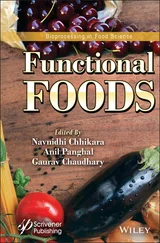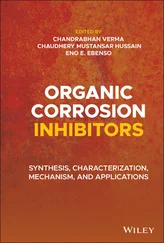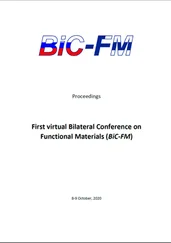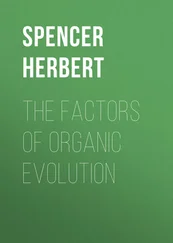Amine function is an ideal gust-adsorptive site to interact with different type of guests. Since it contains positively charged H atoms, it can interact as hydrogen bond donor site. Also, it can interact as hydrogen acceptor or hydrogen bond acceptor site as well as Lewis basic site through its N atom. These multiple chemical features enable amine decorated MOFs to apply as a host for different type of analytes. Their Lewis basicity is potentially suitable to interact with metal ions and their ability to participate in hydrogen bonding is ideal to interact with small organic molecules.
It is reported that MOFs based on central d-metal ions (especially Zn(II) or Cd(II)) functionalized with Lewis basic sites are best sensors toward 2,4,6-trinitrophenol (TNP) with highest K SV(Stern–Volmer constant) and best detection limits [36]. Especially adenine decorated MOFs are best candidate in this field because adenine molecule contain different kind of Lewis basic site especially free primary amine groups which is able to interact with TNP.
Mandal and coworker(s) synthesized [Cd(ATAIA)].4H 2O (where H 2ATAIA = 5-((4,6-diamino-1,3,5-triazin-2-yl)amino)isophthalic acid) for selective vapor sorption and nanomolar sensing of TNP ( Figure 2.2) [14]. The pore walls of Cd-ATAIA are decorated with two primary amino groups and one secondary amino group. Activated Cd-ATAIA displays UV–Vis absorption peaks centered at 278 and 323 nm and fluorescence emission at 376 nm upon excitation at 310 nm. Application of Cd-ATAIA in aqueous solution detection of nitroaromatic compounds (NACs) reveals that activated Cd-ATAIA represents the largest quenching efficiency (98%, 60 µl) in presence of TNP as well as a significant color change (K SV= 1.59 × 10 +7mol −1, detection limit = 0.94 nM). DFT calculation performed to investigate about possible detection mechanism. The results show that there is strong electrostatic interactions and hydrogen bonding between two types of Lewis basic amine groups of the ATAIA ligand and the highly acidic hydroxyl group of TNP. Also UV–Vis experiments reveal that there is large overlap between ATAIA and TNP. As a result of such overlap and host-guest interactions, activated Cd-ATAIA could detect TNP in presence of other NACs. Also, Cd-ATAIA could detect TNP in vapor phase. The results reveal that a visual color change is observable after 30 while a significant quenching in photoluminescence (PL) emission spectra of CD-ATAIA is distinguishable.
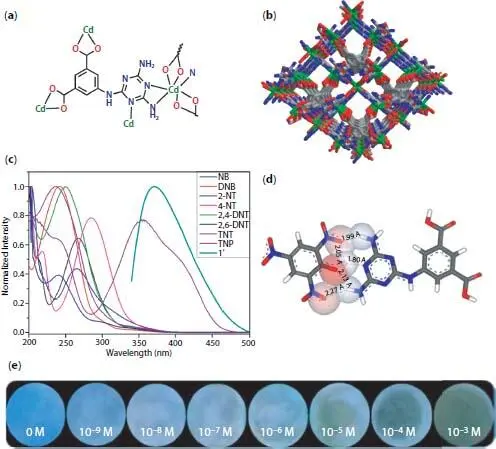
Figure 2.2 Application of [Cd(ATAIA)].4H 2O in detection of TNP. (a) Schematic representation view showing coordination environment around Cd(II) center. (b) Perspective view of packing along c-axis (free guests and hydrogen have been omitted for clarity) (Color code; carbon: grey, oxygen: red, nitrogen: blue, Cadmium: green). (c) spectral overlap of absorption spectra of different nitro-analytes and emission spectrum of activated Cd-ATAIA. (d) Energy minimized structures of H 2ATAIA and TNP complex. (e) Photograph of Whatman filter paper strips coated with activated Cd-ATAIA at different concentration of TNP [14].
Similarly in another work, Bio-MOF-1 can selectively detect 2,4,6-trinitrophenol (TNP) through hydrogen bonding interaction between free amine functions of adenine and acidic hydroxyl group of TNP ( Figure 2.3) [37].
Owing to their Lewis basicity amine incorporated FMOFs could apply in detection of metal ions. Since metal ions are Lewis acid, they can interact with amine group inside pores of FMOFs as Lewis basic guest-interactive site. Through this kind of interaction, some changes could be induced in energy level of N atom of amine or even the metal ion. These changes in energy levels of metal ion∙(N)amine interactions could be distinguished using some analysis like XPS (X-ray photoelectron spectroscopy). Sometime FT-IR analysis through observation of some changes in characteristic peaks of amine or generation of new peak related to metal ion ∙(N)amine bond is useful.
Xin Liu and coworkers applied a amine decorated FMOF, formulated as [Zn 2(TPOM)(NH 2‒BDC) 2]∙4H 2O (Zn-NH 2-MOF, TPOM = tetrakis(4-pyridyloxymethylene)methane and NH 2-BDC = 2-aminoterphthalic acid) for detection of metal ions ( Figure 2.4) [10]. The PL emission peak (λ ex= 353 nm,  ) of this amine decorated MOF enhanced in presence of Cr(III) meal ions owing chelation of N atoms of amine groups and O atoms of free carboxylate groups. Application of isostructure framework without ‒NH 2group, Zn-MOF, reveal that the PL emission of this MOF did not change significantly in presence of Cr(III) ions. This blank experiment confirm the vital role of amine group in detection of Cr(III) ions (detection limit = 4.9 µM) [11]. In other works, Lili and coworkers applied a amine decorated MOF for detection of Hg(II) metal ions (detection limit = 4.2 ×10 −8M, K SV= 4550 mol −1). XPS analysis of this materials after exposure to Hg(II) metal ions reveal a new N(1 s) peak at 406.38 eV indicative of chelation interaction between N atom of amino group.
) of this amine decorated MOF enhanced in presence of Cr(III) meal ions owing chelation of N atoms of amine groups and O atoms of free carboxylate groups. Application of isostructure framework without ‒NH 2group, Zn-MOF, reveal that the PL emission of this MOF did not change significantly in presence of Cr(III) ions. This blank experiment confirm the vital role of amine group in detection of Cr(III) ions (detection limit = 4.9 µM) [11]. In other works, Lili and coworkers applied a amine decorated MOF for detection of Hg(II) metal ions (detection limit = 4.2 ×10 −8M, K SV= 4550 mol −1). XPS analysis of this materials after exposure to Hg(II) metal ions reveal a new N(1 s) peak at 406.38 eV indicative of chelation interaction between N atom of amino group.
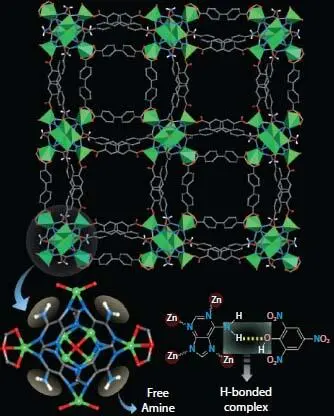
Figure 2.3 3 dimensional framework of bio-MOF-1 along the c crystallographic direction (above) and desirable H-bonding interaction between free primary amine of adenine and hydroxyl group of TNP (down) [37].

Figure 2.4 Application of [Zn 2(TPOM)(NH 2–BDC) 2]∙4H 2O in detection of Cr(III) ions. (a) Coordination environment of NH 2-Zn-MOF representing the free amine and carboxylate groups. (b) Proposed detection mechanism. (c) Change in emission peak of NH 2-Zn-MOF in presence of different metal ions [10].
Host–guest chemistry of amine FMOFs in removal of detrimental analytes from aqueous and other media resembles to detection of metal ions or small organic molecules. So, Lewis basicity and capability to participate in hydrogen bonding are most practical features of amine function in removal of hazardous materials.
Nitrogen containing molecules like pyridine and quinoline (with N sites), pyrrole and indole (with NH sites) are among the well-known oil pollutants. So, they are potentially able to interact with the adsorbent through hydrogen bonding; pyridine and quinoline as hydrogen bond acceptor and pyrrole and indole as hydrogen bond donor. Since amine function is able to interact as both H-donor and H-acceptor site in hydrogen bonding, they could be applied for denitrogenation of oil. In this regard, Sung Hwa Jhung and coworkers synthesized some amine decorated MOFs, MIL-125-NH 2( Figure 2.5) and UiO-66-NH 2, to purify the liquid model oil [15, 16]. Owing to mentioned interactions, host–guest chemistry of NH 2-MIL-125(Ti) is enriched and adsorption capacity toward quinoline and indole is improved in comparison of MIL-125(Ti), 103 mg·g −1vs. 460 mg·g −1for quinoline and 264 mg·g −1vs. 502 mg·g −1for indole [15]. Clearly, this improvement is attributed to presence of amine site. In next move, they protonated amine sites from –NH 2to  for additional improved adsorption capacity of quinoline (546 mg·g −1) and indole (583 mg·g −1).
for additional improved adsorption capacity of quinoline (546 mg·g −1) and indole (583 mg·g −1).
Читать дальше
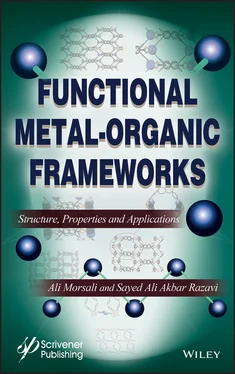

 ) of this amine decorated MOF enhanced in presence of Cr(III) meal ions owing chelation of N atoms of amine groups and O atoms of free carboxylate groups. Application of isostructure framework without ‒NH 2group, Zn-MOF, reveal that the PL emission of this MOF did not change significantly in presence of Cr(III) ions. This blank experiment confirm the vital role of amine group in detection of Cr(III) ions (detection limit = 4.9 µM) [11]. In other works, Lili and coworkers applied a amine decorated MOF for detection of Hg(II) metal ions (detection limit = 4.2 ×10 −8M, K SV= 4550 mol −1). XPS analysis of this materials after exposure to Hg(II) metal ions reveal a new N(1 s) peak at 406.38 eV indicative of chelation interaction between N atom of amino group.
) of this amine decorated MOF enhanced in presence of Cr(III) meal ions owing chelation of N atoms of amine groups and O atoms of free carboxylate groups. Application of isostructure framework without ‒NH 2group, Zn-MOF, reveal that the PL emission of this MOF did not change significantly in presence of Cr(III) ions. This blank experiment confirm the vital role of amine group in detection of Cr(III) ions (detection limit = 4.9 µM) [11]. In other works, Lili and coworkers applied a amine decorated MOF for detection of Hg(II) metal ions (detection limit = 4.2 ×10 −8M, K SV= 4550 mol −1). XPS analysis of this materials after exposure to Hg(II) metal ions reveal a new N(1 s) peak at 406.38 eV indicative of chelation interaction between N atom of amino group.

 for additional improved adsorption capacity of quinoline (546 mg·g −1) and indole (583 mg·g −1).
for additional improved adsorption capacity of quinoline (546 mg·g −1) and indole (583 mg·g −1).
